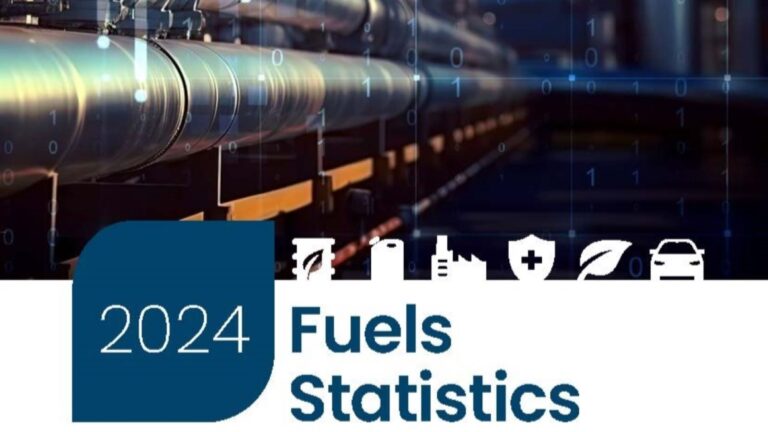
The Fuels Statistics report is an annual analysis of the latest data from the fuel supply sector. Building on the association’s previous publications, the report provides analysis for those working in the industry, policymakers, and all who wish to gain a quantitative understanding of the UK downstream sector.
A vital reference document, the report contains comprehensive information from trusted sources on all parts of the UK fuels supply chain, from where refineries source their crude oil feedstocks, to how many EV charge points are now in operation at the UK’s petrol filling stations.
With the sector evolving, it is no surprise that the report summary suggests that fuels is a sector in which ‘little stands still’, with fluctuating market dynamics, policy shifts, and evolving consumer behaviour.
Some of the headline findings of this year’s report are:
- Fuel prices remaining well above 10 year averages despite year on year drops of 10% and 11% for petrol and diesel respectively.
- Increased supply of lower carbon fuels for transport (over 2800 million litres), now also being used for aviation as well as road fuels (95 million litres).
- Evidence that the COVID-19 pandemic has permanently altered mobility patterns, with overall fuel consumption remaining down around 10% (since before 2020).
A fluctuating market
Flagging volatility as one of the perennial themes of the UK fuel sector, the report finds that this year has been no exception, noting that: “Fuel prices remain high against the 10 year average, long term effects of COVID remain – with demand still below pre-pandemic levels – and sources of imported fuels and locations of exports are still changing markedly year on year, even though sanctions on Russia came into force in 2022.”
The report indicates reduced throughput and utilisation of UK refineries in 2023 with output below demand, and the continuation of a long term misalignment between product demand and supply (too little diesel and jet fuel, too much petrol). Following a huge jump in average refining margins in 2022 due to the Russian-Ukraine conflict, a 22% decrease, from 20.00$/barrel in 2022 to 15.51$/barrel in 2023, still leaves margins significantly above that of 2021, of around 6$/barrel.
The energy transition
The report highlights “a concerted push towards alternative fuels as well as hybrid and electric vehicles with both continuing to grow year on year”.
However, despite a record year for EV registrations, data from the Department for Transport indicates that the rate of uptake is slowing, and petrol vehicles still hold the largest share of all new vehicles sold.
Policy and regulatory changes
The FIUK report also notes the “significant policy and regulatory changes aimed at accelerating the UK’s energy transition and ensuring energy security” introduced during the year.
Zero Emission Vehicles Mandate
One of the significant changes was the enshrinement in law of the pathway for zero emissions vehicles transition by 2035. The introduction of the Zero Emissions Vehicles Mandate, in January of this year, will see manufacturers obligated to sell an increasing number of zero tailpipe emissions car and vans.
The mandate sets out the percentage of new zero emission cars and vans manufacturers will be required to produce each year up to 2030. With a starting rate of 22% in 2024, the mandate increases the percentage each year, reaching 80% of new cars and 70% of new vans sold in Great Britain by 2030, and 100% by 2035.
Sustainable Aviation Fuels Mandate
The UK Government also announced the introduction of the Sustainable Aviation Fuels (SAF) Mandate, a policy that requires a certain percentage of jet fuel used in the UK to be SAF.
The mandate will encourage the innovation of advanced fuels that can generate greater emission reductions and the diversification of feedstocks to reduce dependencies on scarce resources, by including in the mandate:
- A cap on the feedstocks used in the hydroprocessed esters and fatty acids (HEFA) process, but not until other types of SAF are also commercially viable to recognise the important part that HEFA SAF will play in the 2020s. HEFA supply will not be limited under the mandate for the first 2 years, fall to 71% in 2030 and still contribute 35% in 2040.
- A separate obligation on power to liquid fuels from 2028 that reaches 3.5% of total jet fuel demand in 2040.
The mandate will include a buy-out mechanism for both the main and power to liquid obligations, set at £4.70 and £5.00 per litre of fuel, respectively, to incentivise supply while protecting consumers where suppliers are unable to secure a supply of SAF.
These provide a significant incentive for fuel suppliers to supply SAF into the market rather than pay the buy-out. They also set a maximum price for the scheme, and therefore deliver emission reductions at an acceptable cost. The plan includes a review mechanism to help minimise the impact on ticket fares for passengers.
The mandate will begin in 2025 with the percentage of SAF increasing gradually from 2% in 2025 to 10% in 2030, and then to 22% in 2040. The mandate is part of the government’s “jet-zero” strategy to decarbonise air travel, but there are fears that emissions reduction achieved through the mandate will be largely offset by rising demand for air travel.
SAF revenue certainty mechanism
The bill outlining the SAF mandate, announced on 17 July this year, will also introduce a Revenue Certainty Mechanism (RCM) for SAF producers who are looking to invest in new plants in the UK.
This builds on the SAF mandate, which will create demand for SAF by setting targets on fuel suppliers to use a proportion of SAF.
There are a number of SAF projects being developed across the UK. Bringing in a Revenue Certainty Mechanism will help to reduce risk, giving investors the confidence they need to invest in UK SAF plants. It will increase the likelihood SAF plants will be built in the UK, thereby securing a supply of SAF for the UK aviation sector and supporting the delivery of the SAF mandate.
This year’s Fuels Statistics report includes new information on SAF demand and production as well as the Mandate trajectory to help track this emerging market segment.
Renewable fuels
The volume of renewable fuel deliveries has continued to grow in line with the growing RTFO, although the UK did not meet its RTFO target, resulting in the payment of a small buy- out. There are also growing deliveries of SAF in advance of the planned mandates from 2025.
Deliveries of renewable fuel have increased by 2.6% in 2023 from 2764.5 to 2871.1 million litres, with a decrease of 3% in biodiesel and an increase of 12% in bioethanol. The UK imports most of its renewable fuels, with many coming from Asia.
In terms of feedstocks, RTFO double counting and the specification limit of 7% FAME in forecourt diesel means waste-derived sources are better placed to meet obligations and they make up 66% of total feedstocks in 2022 – an increase of 12% on the previous year due to the impact of the crop cap and RTFO limit increases.
UK renewable fuel feedstocks were mostly from used cooking oil, with China the top import location.
In 2023, 95.88 million litres of SAF feedstock was used in the UK. The UK provided 7.68 million litres (8%), which means the UK is reliant on imports to meet demands. Without changes to SAF feedstock availability, the UK will have to import the majority of its feedstocks to meet the SAF mandate obligations.
Emissions
Despite increased economic activity in 2023, the UK economy’s greenhouse gas (GHG) emissions have remained below pre-pandemic levels, and emissions of both greenhouse gases and air pollutants have been falling across the last decade, driven by improvements in technology and regulation.
The sectors with the highest emissions continue to be domestic transport and buildings and products uses, both contributing 31% to the total.
The UK has continued to over perform against its GHG emissions targets set out in Carbon Budget 3 and the total GHG savings of 2022 show the UK is on track to meet or exceed the new targets set out in Carbon Budget 4 that begins in 2025.
Commenting on the picture for the fuel sector, Elizabeth de Jong, Chief Executive Officer at Fuels Industry UK said: “It was a mixed picture within our sector, with refining CO2 emissions growing by 1%, and sulphur dioxide emissions also up (13%), but there were notable reductions in particulate matter (down 17%) and non-methane volatile organic compounds (down 8%), while nitrogen oxide was flat.
“The diverse changes year on year likely reflect changes in operations in response to changes to demand and crude feedstock availability with refiners optimising their set-ups accordingly.”
Following the report findings Elizabeth concluded: “As always, little stands still in the fuels sector and this year has been no different.
“The past year has seen fluctuating market dynamics, policy shifts, and evolving consumer behaviour, through which the sector continues to supply the fuels the UK needs.”
Fuels Statistics 2024 is available on the Fuels Industry UK website.
Image credit: Fuels Industry UK

